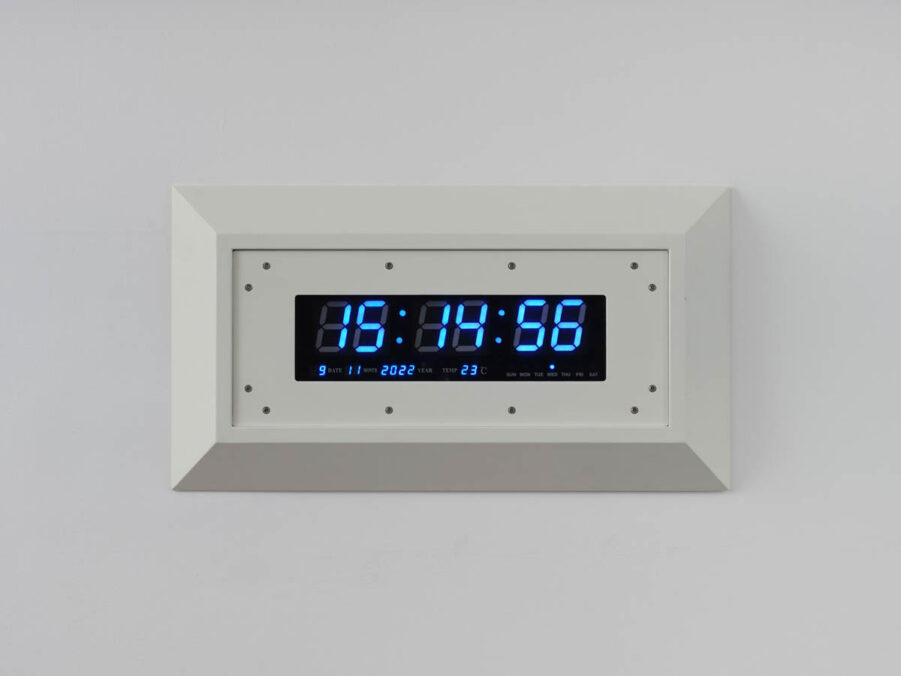
Martin Beck, Sung Tieu. echo* at Grand Hall
The summer exhibition echo* interlaces the artistic practices of Martin Beck and Sung Tieu. The exhibition creates an environment where the resonance of sound meets the solidity of institutional infrastructure, delving into temporal and spatial contexts at the same time.
Central to the exhibition is a collaborative sound installation by Beck and Tieu in the corridor enveloping the Kunstverein’s main exhibition space. The installation features an intricate network of 28 speakers arranged to produce a continuous sonic environment. The soundscape, alternately programmed by both artists, ranges from the chirping of crickets and howling bursts of winds to the tumult of a thunderstorm, each adding its narrative and emotional depth into the space. This resulting experience is as fluid and shifting as the historical and political contexts Beck and Tieu draw from in their individual works presented in the main exhibition hall.

Sung Tieu, known for her minimalism-critical approach, explores the tensions arising from design and its social application. Her installations compel us to consider the unseen layers of political narratives woven into everyday spaces.
Tieu contributes two digital clocks, each set to different time zones linked to incidences of Havana syndrome around the globe.
As a new commission, she produces a text-based work as part of her series Newspapers 1969–ongoing that interlaces personal biography and the kunstverein’s institutional mechanics. The newspaper serves as a sculptural and textual element blurring the lines between the archival and the immediate, the factual and the imagined.

Martin Beck’s practice is deeply engaged with processes of imaging, broadening our understanding of visual and auditory cultures. The main reference point for his most recent body of works is a series of eleven vinyl records titled environments released between 1969 and 1979 as psychoacoustic tools designed to enhance productivity and well-being. Beck probes these claims, laying bare the rhetoric of a then-nascent industry. Building on this exploration, he contributes four large-scale drawings adorned with fern foliage that probe the themes from sites to sounds, tasks, and time. Additional works cut into the record series’ covers to highlight the visual and verbal dimensions associated with the paradoxical pressures of self-care and self-control in contemporary capitalist culture.
This juxtaposition of Beck and Tieu’s works allows for a reflection on how psychological and physical spaces are constructed as well as for understanding echos as not just an auditory but a historical and cultural experience.
Sung Tieu (*1987, Hai Duong, Vietnam) studied Fine Arts at the University of Fine Arts, Hamburg and at Goldsmiths College, London before completing her postgraduate work at the Royal Academy of Arts, London. Living in Seoul Sung Tieu’s work is largely based on historical and political research. She often connects historical events with biographical elements related to her Vietnamese background.
Martin Beck (* 1963, Bludenz, Austria) has widely exhibited his work in Europe and the United States. Recent solo exhibitions include Last Night, Museum of Modern Art, New York (2024), dans un second temps, Frac Lorraine, Metz, France (2018); Rumors and Murmors at Museum Moderner Kunst Stiftung Ludwig Vienna, Austria (2017); and Program at the Carpenter Center for the Visual Arts at Harvard University, Cambridge (2014–16). He lives in New York and Vienna.
Philipp Fleischmann. Flashes of Resilience at Studio Space
Philipp Fleischmann’s artistic practice challenges traditional forms of filmic representation, opting for strategies that emphasize the undefined and the obscured through the lens of queer abstraction. Fleischmann’s approach often involves the development of site-specific cameras, tailor-made for each project to explore and reflect the nuanced physical and cultural dimensions of various institutional spaces.
For Flashes of Resilience at Salzburger Kunstverein, the artist developed a new looped 735 cm long film sculpture, where the 16mm filmstrip carries various conceptions which sidestep traditional frame inscription, hence accentuating the dynamic and ever-changing perception of the visuals. The title’s flashes are not merely visual but integral to the narrative and thematic depth of the work, embodying moments of intensity and disruption that resonate with the overarching theme of resilience. The attention to color, light, and spatial arrangement encourages constant sensory shifts and reflects the effort and resilience needed to navigate the complexity of attribution and the ability to act.

This seventh iteration in a series of film sculptures incorporates a new design and conceptual framework, progressively interrogating and expanding the expressive potential of analog film. The sculpture at Salzburger Kunstverein introduces a new form and a high projector setup, altering how the film interacts with the surrounding space. These modifications transform the visual and auditory experience, highlighted by the classic projector’s distinct sound, adding a layer of cinematic ambiance to the space.
Philipp Fleischmann (*1985, Hollabrunn, Austria) is an artist based in Vienna. His primary medium is analog film, through which he expresses his unique artistic vision. Fleischmann is known for developing site-specific cameras for his projects, allowing him to delve into and reflect upon the physical and cultural aspects of institutional spaces. Currently, he is exploring the concept of ‘queer abstraction’ in film, pushing the boundaries of traditional filmic expression.
Exhibitions: Martin Beck, Sung Tieu. echo* & Philipp Fleischmann. Flashes of Resilience
Exhibitions Duration: 13.07.2024 – 08.09.2024
Opening: Fri, 12.07.2024 | 8pm, Grand Hall & Studio Space
Address and contact:
Salzburger Kunstverein
Künstlerhaus
Hellbrunner Straße 3, 5020 Salzburg
www.salzburger-kunstverein.at




